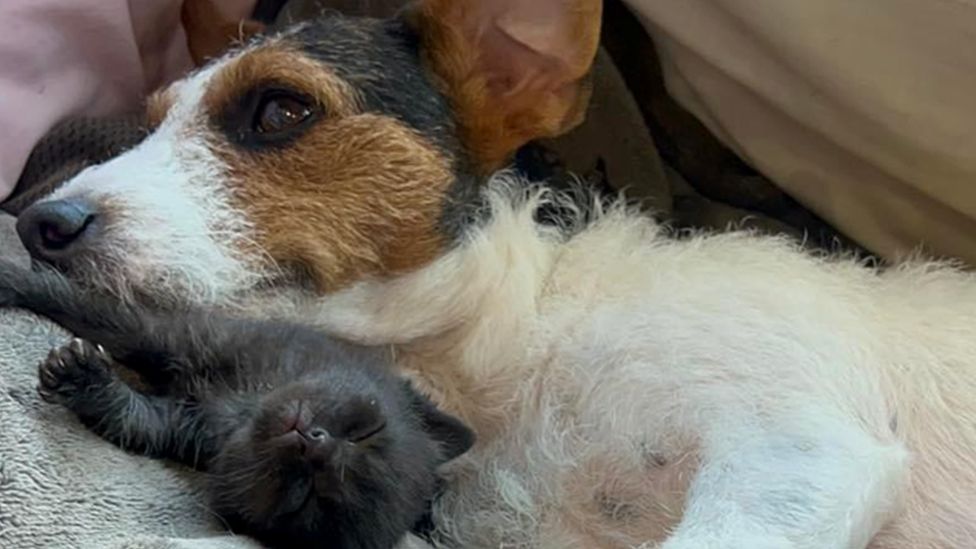Why did a dog in Newmarket end up nursing a litter of kittens?
- Published

Sue Stubley says Teasel spends her nights cuddled up with her "kitten-pups"
Hours after Sue Stubley brought home six abandoned kittens, something peculiar happened - her dog began lactating and the hungry kittens latched on to feed. Cute? Certainly. But why would a dog want to nurture a kitten and how common is inter-species nursing and adoption?
The original plan was to look after the kittens for one night and take them to a local cat rescue the next morning.
Teasel, a two-year-old Jack Russell, had other plans.
"My dog decided that she was going to look after them," says Ms Stubley, who lives in the Suffolk town of Newmarket. "She was cleaning them, and within a few hours, was making milk.
"She stays cuddled up to them all night."
Teasel the Jack Russell began caring, cleaning and feeding the abandoned kittens within hours of them being brought home
Teasel's maternal instincts do not stop with feeding and cuddling her kitten-pups.
"If anybody comes in who she doesn't know and the kittens have gone astray, she'll pick them up and put them back into bed," says Ms Stubley.
Such upending of the stereotypical canine-feline relationship is far from unheard of.
In Liverpool, for example, a shih-tzu puppy named Hope, which was rejected by its mother, was adopted by a Siamese cat whose kittens were born on the same day.
A bald eagle feeds a baby red-tailed hawk (the two species are typically mortal enemies)
Of course, it is not just cats and dogs that occasionally adopt each another's young.
In 2016 a cat in Ukraine with her own litter of kittens took on an additional labour of love - becoming a "mother" to two rescued baby squirrels.
Then, in 2017, eight orphaned hedgehogs in the Russian city of Vladivostok were saved after kindly cat Muska adopted the spiky brood when their mother died in a lawnmowing accident.
And in British Columbia a pair of bald eagles took a baby red-tailed hawk (the two species are typically mortal enemies) under their wings in 2017 and raised it along with their own three chicks in the nest.
So what is going on?
Biologist Dr Rachel Grant, at London South Bank University, says such interspecies "adoptions" are probably the result of "fixed action patterns", in which the adopting animal is responding to a "certain trigger" from the adoptee.
Dr Rachel Grant says the cues which are driving maternal behaviour in mammals are very similar
"This sets off a cascade in the brain that elicits a pattern of behaviour," says Dr Grant.
Baby birds, for example, will see the red area on the mother's beak and peck at it. The mother returns the gesture by responding to the red area of the baby birds' gaping mouths.
"It is a signal," says Dr Grant.
A signal, it turns out, that can be manipulated. Cuckoos, for example, exploit these "fixed action patterns" by getting other birds to raise their young for them, external. Baby cuckoos tend to have the largest red mouths in the brood, meaning they are well taken care of.
Dr Grant says the closer species are to one another, the more likely a cross-species adoption will take place, meaning it is very unlikely you will ever read about a crocodile nursing a chihuahua puppy.
While cross-species nursing might be deeply endearing and eminently shareable on social media, it surely runs counter to our understanding of evolution
"In baby mammals there will be certain features that mammals share with other mammals," Dr Grant says.
"Cats and dogs, for example, are both mammals and the cues which are driving maternal behaviour are very similar. They will be responding to certain cues."
As for the young, they too are acting on instinct. So the kittens in the case of Teasel are instinctively "rooting" - just like human babies or puppies - for a nipple to feed on.
"These things are not under conscious control," says Dr Grant.
While cross-species nursing might be deeply endearing and eminently shareable on social media, it surely runs counter to our understanding of evolution.
Yes and no, according to Dr Grant.
"As long as it works 99% of the time it will be selected by evolution," she says.
So the strong maternal instinct shown by Teasel stands her in good stead to raise her own young, should she one day have pups of her own.
That those instincts have been co-opted by a litter of needy kittens works out well for the kittens - and does not harm Teasel.
What would be interesting, according to Dr Grant, was what would have happened if Teasel already had a full litter of her own pups
What would be interesting, according to Dr Grant, was what would have happened if Teasel already had a full litter of her own pups.
It is, perhaps, far less likely Teasel would have been quite as maternal towards them.
What does the future hold for Teasel and her kittens?
"I think once weaning has occurred, the bond is likely to lessen off," says Dr Grant.
Which is just as well, because all of the kittens have new families lined up to give them homes.
Follow East of England news on Facebook, external, Instagram, external and X, external. Got a story? Email eastofenglandnews@bbc.co.uk , externalor WhatsApp 0800 169 1830
- Published3 November 2023